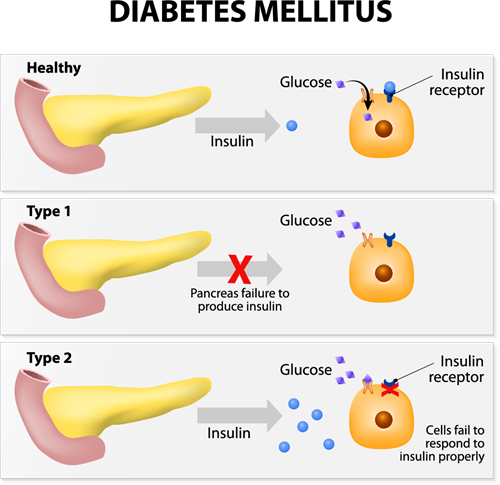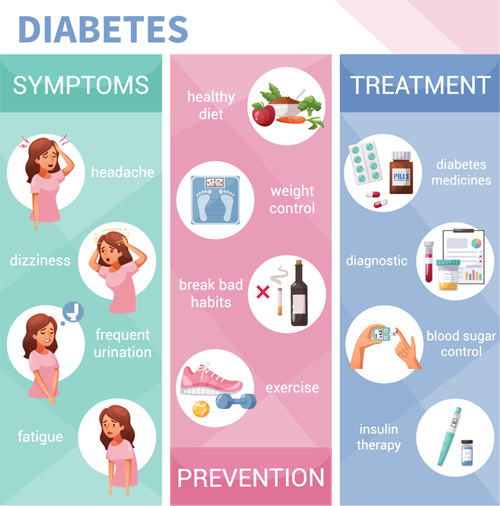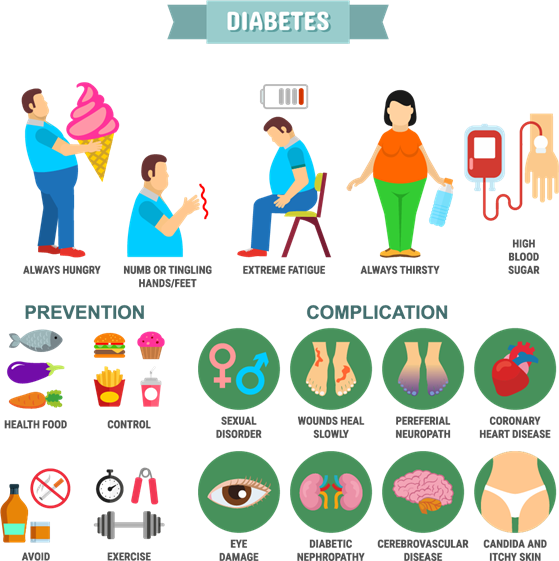PDF chapter test TRY NOW
In the previous theory, we saw diabetes mellitus and its types. In this theory, we shall see the prevention and control of diabetes.
Management options include diet, hypoglycemic drugs, insulin injection, and exercise, depending on the type and severity of diabetes. The allover goal of diabetes management is to maintain normal blood glucose levels.
Difference between type 1 and type 2 Diabetes Mellitus:
Factors | Type-\(1\) Insulin dependent diabetes mellitus (IDDM) | Type-\(2\) Non-insulin dependent diabetes mellitus (NIDDM) |
| Prevalence | \(10\)-\(20%\) | \(80\)-\(90%\) |
| Age of onset | Juvenile onset (\(< 20\ \)years) | Maturity onset (\(>30\ \)years) |
| Bodyweight | Normal or underweight | Obese |
| Defect | Insulin deficiency due to destruction of β-cells | Target cells do not respond to insulin |
| Treatment | Insulin administration is necessary | Can be controlled by diet, exercise and medicine |

A picture explains the healthy, type-1 and type-2 Diabetes Mellitus.
Dietary management:
Low carbohydrate, high fibre diets are preferable. Carbohydrates should be consumed as starch and complex sugars. Sugars that have been refined (sucrose and glucose) should be avoided. Whole grains, millets such as jowar, bajra, and ragi, green leafy vegetables, wheat, and unpolished rice are included in the diet. It should consume regularly.
- Carbohydrates are retained to about \(50\)-\(55\) per cent of total calories.
- The high protein content of \(10\)-\(15%\) of total intake is required to supply essential amino acids.
- Dietary fat should account for \(15\) to \(25%\) of total calories.
- Should reduce the consumption of saturated fats.
- The polyunsaturated fatty acid content should be increased.

A picture explains the symptoms, prevention and treatment of Diabetes Mellitus.
Management with insulin:
Commercially available short and long-acting insulin preparations are also used to maintain blood glucose levels stable.
Physical activity:
Exercise, strengthening and toning the muscles play an essential role in facilitating reasonable diabetes control.
Education and awareness:
- People who live with diabetics should be educated about the nature of their disease and the possibility of complications if blood sugar is not kept under control.
- Diet, exercise, and drug instructions should explain to the persons are affected by diabetes.

A picture explains the complication and prevention of Diabetes Mellitus
Important!
Flax seeds, which contain insoluble fibre and guavas, tomatoes, and spinach, help lower blood sugar levels.
